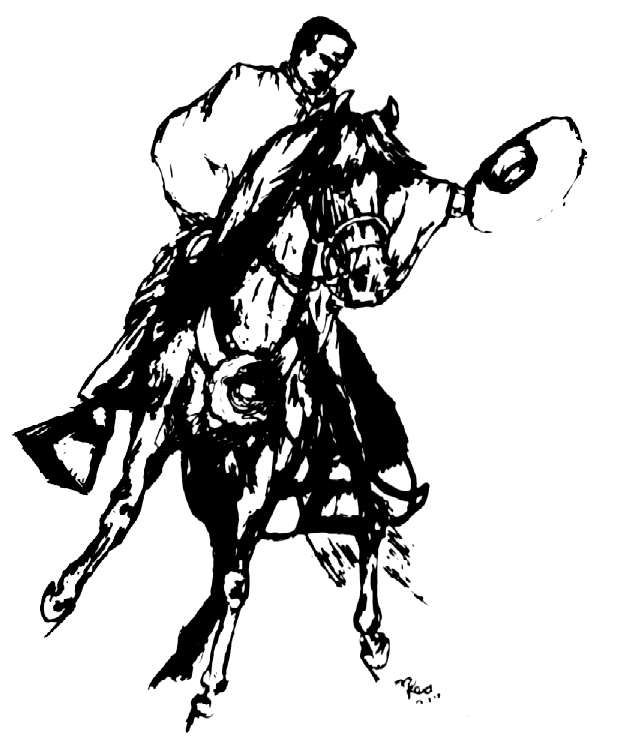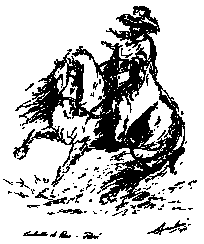


Would You
Enjoy Some Background Music
While You Tour This
Page?
Just click on the arrow to start and the box to stop. Enjoy!
There have been periods in history when extraordinarily large numbers of outstanding men seem to have appeared inexplicably all at once. Some believe that this is some sort of coincidence but others theorize that the stimulation and example of great men goes a long way toward developing the potential to be great in other men. If true the second theory would explain why the best of the chalanes from the golden age came from a very few areas in Peru and almost always grew up and worked together.
On the following pages the reader will find a bit of information on some of the best known modern Chalanes. They were an exceptional group of men and so far their replacements do not appear to be on the horizon, Maybe they were special men in special circumstances who can never be replaced.
Distant relatives as well as boyhood chums, Pedro and Ricardo would both one day be honored with a title bestowed upon very few, that of master trainer. In the late 1920's after Soltero had been working at Casa Grande for 4 or 5 years, Torres joined him there.They worked together at Casa Grande for about three years and then left together and went to work at Chilcin. After a half year at Chilcin, Pedro became seriously ill and returned to his parents home in Guadalupe.
Horse training was not a particularly promising profession in those days; and after his recovery, Torres spent the next 5 or 6 years as a middleman in agricultural sales. When his father died, Pedro was selected to work the small family farm with its herd of some 60 cattle and three dozen horses. The small inheritance was diminished by drought and an epidemic of hoof and mouth disease. Torres began training horses again, this time in exchange for feed for his animals during several years of drought.
It was at that point in his life that a horse sale to which he was not a party in any way shaped Pedro Torres entire future. The horse was named Desprecio and was sold by don Jose Zapata of Pacanga to Roberto Castenada, acting as agent for Pucala. One of the owners of Pucala, don Miguel Enrique Yzaga. ordered the horse returned to the seller because, though he was very beautiful his gait was not good. Zapata insisted that the sale was final. Castenada, who was a horse trader and sold many horses to Pucala brought Desprecio to Pedro Torres for training, in the hope that the results would make the horse satisfactory to his new owners.
When Desprecio was returned to Pucala After training, the manager there, Miguel Maurtua, was impressed by the great change he saw in the horse. He sent three more horses to Torres for training. Not long thereafter,Torres was hired as a full time trainer for Pucala, and he was one of the principle trainers by the time Pucala horses went to their first competition in Piura in 1955. Mainly due to the enthusiasm of Miguel Maurtua and Juan Pardo, Pucala took horses to the National Show in Lima in 1956. Among the successes of the Pucala horses was the championship won by Carnaval and Mantaro's first prize in the bozal.
After that very successful initiation into the show ring, the Pucala horse operation fell under the control of Dr. Guillermo Cepeda, who became Pucala's General Manager, Cepeda gave great importance and stimulation to the horse breeding operation. Cepeda, a Mexican, had been a horseman in Mexico and brought a great knowledge of horse care with him to Pucala.
During his years at Pucala, Torres became recognized throughout the entire country as a master trainer. He worked with other trainers during his many years there, mostly notably Abel Rios, the father of Segundo Rios who has worked for several of the top breeding farms in the United States and presently works for Hyder Mountain Horse Farms in North Carolina. Torres retired after Pucala was nationalized during tee Agrarian Reform, but he has recently come out of retirement at more than seventy years of age to go to work for Olaf Hein at his beautiful new Tres Canas breeding farm near Lima.
Torres' long time companion, Ricardo Soltero followed a rather different road to his eventual recognition as a master trainer. After working at Chiclin, he went on to work for a time at the Hacienda Palomino of Federico de la Torre Ugarte,. Next he went to Pucala and then finally to Eugenio Isolas Mayorazco near Lima.
A very prominent man, Isola made gifts of Peruvian horses to such prominent foreigners as Marcos Perez Jimenez, one time Venezuelan strongman, and Argentine Dictator Juan Peron. The horse given to Peron was named Provinciano, and Soltero accompanied the horse to Venezuela and stayed there for several months. When Mayorazco ceased its breeding activities, Soltero went to work for Pedro Cabrera and then for Fernando Peschiera in Chincha where he was employed and esteemed for many years until his death.
Sixto, himself a student of Caceda's also Iearned a great deal while working with Ricardo Soltero, when the two worked together at Chilcin. Chavez never did change jobs, staying with Chilcin which became a part of the Cartavio cooperative when both were expropriated during the Agrarian Reform; but he did twice take a leave of absence in order to work in North America, most recently for Rory and Mimi Busk MacLeod's Crescent Moon Ranch in Canada. There are some who consider him to be the very finest master trainer alive today.
Jose AIva, who also worked in the U.S. for a short while, was another of Caceda's students. Alva's father, Daniel, also taught him a great deal the classical training of the Peruvian horse. Jose, himself, as a young man worked at Sausal, an annex of Casa Grande. With brief interruptions, Alva has worked for Casa Grande most of his life. For a while he was employed by Nazario Villafuerte of Lima and also worked for the W.H. Marcum family in the U.S.
Yet another well known student of Enemicio Caceda was his nephew, Santos Placentia, one of a large number of member~s of the family who were horse~ trainers. Santos lived and worked for many years in the Paijan-Trujillo area where he learned his craft. He was aquebrantador ("breaker"or "gentler") for a while in Paijan and met Pedro Torres and other trainers while there. Anibal Vasquez sent him to Fernado Peschiera's hacienda in Chincha with a group of mares Vasquez had sold to don Fernando. Based on Anibal's recommendation, Peschiera hired Santos. Santos worked there with Ricardo Soltero until he was given a long leave-of absence to work at Bill McClenahan's Cypress Ridge Ranch in California. Santos then returned to Peschiera's San Fernandito and resumed his duties there. he next worked for Vivienne and Charles Lundquist in California at their Meadow Springs Ranch and now works for Poso Creek Ranch, owned by Dorothy Owens and Alice Nunes, in Bakersfield, California.
After the death of don Federico de la Torre Ugarte, Briones stayed on palomino and worked with Fernado Ceruti while he was General Manager there. When the Agrariam reform began expropriating land in the north. Palomino was taken from her former owners and annexed by the cooperative at Cayalti, also expropriated. At that time Briones became the head trainer at Cayalti where he is still training horses at the time of this writing.
In the later part of his life, Leon became interested in leaving behind some students, and he freely offered his knowledge to several young, aspiring trainers. Three of his best students who presently work in the United States are Nicanor Juarez, Juan Gallegos and German Baca.
Leon suffered a heart attack just a few hours after he finished a day's horse training and died in don "Pepe" Musante's car on the way to the hospital with his wife, a fellow employee and don "Pepe".
Following more than eight months of extensive lessons from Valeriano, Rodriguez was able to land a job with one of the better breeders of the time in the north, Juan Ruesta of Piura where he worked five years before Ruesta's horse breeding operation diminished in size to the point where he was no longer needed. Next he went to work for Jose Antonio Onrubia, where he managed to gain a national reputation for his work in retraining the great *Piloto. When the Agrarian Reform affected Onrubia's lands, Rodriguez came to work in the United States where he first worked for the Thunderbird Ranch and then Jim Foster's Peruvian Pasos del Sur.
Later father and son went to work for Domingo Seminario in Piura. When he returned to the Lima area, young Hilario began to train horses, working for himself. Both Hilario and Amador worked for a time, but not at the same time, for Mario Canepa of the Hacienda Puente, and later on both did some work for Jose "Pepe" Musante, Sr. During his years as a free lance trainer in the Lima area, Hilario also did work for Jose "Pepe" Risso, Carlos Parodi and Manuel Mazzi. Then came an 11 year stint working for Andres Arata at the Hacienda Aguilar in Callao, followed by more free lancing in Lima. In the early 1070's Hilario came to California to work for Bill McClenahan's Cypress Ridge Ranch, and after that he began doing some free lance training in the U.S.
It is said that he longed a horse with the style and grace of a bullfighter or a dancer. he was the equitation teacher of such notable aficionados as Carlos Luna de la Fuente, Carlos Parodi and Jose Antonio Dapelo, Jr. he worked for many years for Jose "Pepe" Musante, Sr., who still speaks of him in superlatives and who still treasures the poncho which Orbegoso was wearing on the day he died. In the words of Musante, "He had rhythm with horses that distinguished him completely from ordinary mortals." Orbegoso also trained horses for Roberto Risso, the father of Raul and Jose, at the Hacienda Lobaton.
One day, at 80 years of age, while Orbegoso was getting ready to ride "Pepe" Musante's Llorencito in a parade along Lima's Avenida Alfonso Ugarte, Carlos Luna noticed him taking a number of pills. The trainer suffered from angina pectoris, and Luna recognized the pills as those which had been prescribed for that very problem.
Softly Luna advised him, "Don Juanito, it is best that you don't ride today."
He independent and quick witted Orbegoso unleased his razor sharp tongue and answered, "At the end of my life, don Carlos, who will die? You or me?"
Luna walked away still concerned for his old friend and teacher. Orbegoso rode in the parade, and along the way he died.
Felipe Marchena
During most of his life Marchena has been a free lance trainer, and over the years he has worked for Juan Miguel Rosell, Rafael Puga and Rudolfo Venturo. For a short while in 1979 he worked at Bob and Cheryl Bayer's Pepper Tree Ranch in California.
Ambrioso Bernabe Arana grew up in Jequetepeque and began free lance training before he went to work for a series of distinguished employers such as Federico de la Torre Ugarte, Pucala, Jorge Baca in Reque, dona Carmela Zapata de Aramburu and Juan Thorne at Puente Piedra near Lima.
